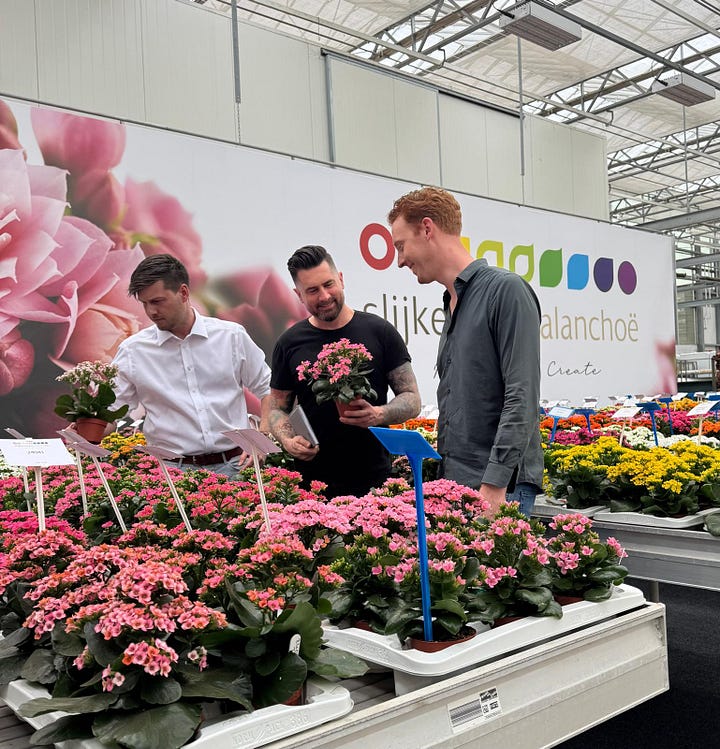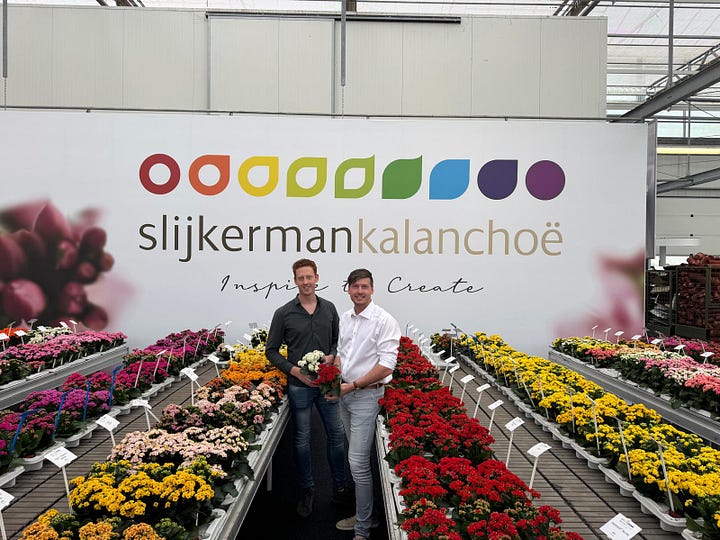The secrets of Kalanchoe- 'Flaming Katy': Revealed!
Exclusive info from my trip to kalanchoe specialists Slijkerman
Probably one of my earliest houseplant memories is my Little Nana's 'Flaming Katy' plant (and yes, I had a 'Big Nana' and a 'Little Nana'- they were arranged by height). This original 'Flaming Katy' aka Kalanchoe, was the most perfect red little star flowers and I remember the fresh green leaves. Just thinking of it now brings me a little joy.
You can still buy Flaming Katy plants just like that in the garden centre, but there's also so much more. I'd be confident saying it's possibly one of the houseplant families which has had the biggest glow up over the years. Today's selection is utterly mind-blowing, and I am so excited about what's coming too - nowadays there are even cut flower types and it's also potentially tipped to be the next must-have bedding plant. Ya what? On behalf of Decorum Plants and Flowers brand (of whom I am an ambassador), I took a visit to breeding company, Slijkerman, in North Holland to find out the full story of their innovation!
I met with Stef and Steven, who gave me a tour - btw their boss is called Stefan too. I clearly can't get a job at this place!


Like many Dutch growers, the Slijkerman family started with growing vegetables, back in 1946. As glasshouse growing became more popular in the 70s, they switched to slightly more exotic crops, such as Gerbera (yes, remember when that was the must-have houseplant…) and Begonia elatior. Disaster later struck with the Begonias crops, as a fungus took hold, and Slijkerman made a decisive switch to Kalanchoe, in those days referred to as a Flaming Katy (not sure why, I'll let you do that Google leg work…)
Originally, Slijkerman were very happy just growing Kalanchoe for garden centres across Europe. But, around 20 years ago, the market suddenly took a shift as a new kid on the block appeared. Calandiva entered the chat. A random sport appearing in a crop of the usual type of single flowered Kalanchoe, this new flower formation had extra petals - giving the appearance of a crested centre. Slijkerman began growing this crop commercially. Then, as happens with many developments in the plant world, nature had its way. A random mutation, also known as a sport, appeared in their crop. They now had their own double-flowered Kalanchoe!
Slijkerman then got the breeding bug, and began growing many varieties, hybridising, and creating new types. One of a few Kalanchoe breeders in The Netherlands, Stef Berkhout, Manager of Breeding, tells me rivalry is always good: it keeps you sharp!
So, as ever with breeding, the traits they're looking for are sometimes visible, sometimes not. For the grower, Slijkerman need to speed up production times, and there's also pressure to breed plants that don't need any treatment to keep them small and compact. Naturally short types are slower to flower though, so that does give the team a small dilemma…
For the consumer, of course we want shiny new colours, but also shelf life is important. Slijkerman aim for 8 weeks of flowering from the moment they leave the grower, so once in the house this defo beats carnations! Now, you might be thinking, why doesn't my Kalanchoe re-flower? Well, maybe you're lucky - but they need short day treatment (like a Poinsettia), so a second flush is usually rare, but not unknown.
In the growing house, the curtains close at 5pm each day to achieve this, opening again at 7am. Unless you wanna live like a hermit at home, I suggest you simply buy another Kalanchoe.
Interestingly, and maybe scary to some (unsure why), but the glasshouse is entirely run by computer and there are no people in it, just two machine robots, which ferry the plant tables around, moving plants where they need to be - either to grow on further or come into the warehouse for processing and packing.
All cuttings are produced from mother plants in Kenya, and they're shipped in twice a week. A mother plant (the plant which cuttings are taken from) can provide cuttings for up to 30 weeks, that is hard working! Cuttings root in 10 days, and a plant is ready (after a 10 week blackout) after around 14 weeks. Grown generally at 20C, any cooler and the crop matures slower. Time means money!
In terms of appearance, as Kalanchoe are usually a gift plant, and sold in bloom (though not in full bloom)... so, the team look for plants that branch well, with small leaves that don't get in the way, a good spread of flowers too - and in unique and amazing colours.
I am always so intrigued with breeding aims, so I asked loads of questions, some of which they didn't answer LOL. But, I can confirm everyone in the Kalanchoe world would like to create a blue one! Purple is the closest, but even that is pretty tough to achieve. Colour changing types are also a focus - in years gone by, they would have been rejected as unstable, but it turns out the effect is pretty damn cool.
Soooo, here's where it gets exciting. Traditionally seen as a houseplant, and a bloody easy going one too. Kalanchoe is basically a succulent, forget to water it and it loves you forever... almost! With warmer summers, Kalanchoe is easily becoming a nice option for outdoor planters and window boxes, especially with its drought-enjoying capabilities.
Always being a pioneer (ahem...), I did already work on some content with outdoor Kalanchoe - see here. But, I think we were ahead of our time... Slijkerman is trialling some awesome types, which will be sold in an 8 pack, ready for planting outdoors, to give that 8-10 weeks of colour. A pretty interesting plant, which could shake up the bedding market. When I grew them, they also re-flowered gently too, covering over the old blooms with new fresh heads.
And, then, whilst you're a vulnerable state, I am going to shock you again... Kalanchoe can be a cut flower.. (again, I predicted this 2 years ago, ahem - see here). A very interesting development, and it's quite insane (in a good way) that breeders have selected a short dumpy plant to have long, foot long stems. Growers haven't quite taken to the crop yet, but let's start the campaign here. Long lasting stems, thanks to being so succulent, with pastel tones and a decidedly vintage look - perfect for bouquets. Vase life is 5 weeks.
Being so damn curious, I still keep asking questions... Turns out the market changes with the season too - spring means sales of reds, yellows and oranges, whilst summer is more straight colours. Autumn moves onto pastel tones, and Christmas means sales shoot up for reds and whites!
I also picked Stef and Steve's brains on which colours sell in which countries - and maybe predictably scandinavia loves pastel tones, whilst France likes bright colours and only buy when the weather is sunny, Poland relies on National Days, such as Women's Day, and Italy loves to buy in bud, since they flower so much quicker for them in a warm climate.
Slijkerman and their team of sellers are so sophisticated, even when they send a mixed tray of colours, they can tell which colours were most popular at the till! Oof.
Well, guys, I think it's time to dig into 17 (yes, 17) of my favourite varieties from my visit, some are new and ready to roll, others are unreleased and I hope I don't get into trouble for showing you photos, hehe!!
20094
Amazing pink orange glow, and tonnes of flowers!
‘Lipstick’
Their very first creation.
5016
A unique cherry red just like my Nana used to grow.
‘Patio’
A nice big flower, could be good for outdoors.
23042
Fantastic colour, and I love that centre!
18072
One of my colour changing favourites.
‘Diamond Snowflake’
A super unique double flower type.
23023
The colour of a Marigold!
23041
I love these rounded flowerheads - just like a rose.
22056
A very low habit, could be nice for a table top planter.
‘Sylca’
Very unique, and apparently very popular in Brazil!
23043
A lovely botanical style - could work outdoors.
23004
Wow wow wow!
20081
The most perfect Easter yellow!
20056
Another colour changing beauty.
21119
So many flowers you can’t even see the foliage - there must be 150 flowers here!?
‘Serenity Light Red’
I love this soft version of the red.
About Decorum
Decorum brings together over fifty Dutch growers under one premium label.
I’m on a mission to visit as many of these independent, family-run businesses as possible, and I’m having a fantastic time.
Decorum growers are united by shared values, and have together established a trusted name recognised for a commitment to quality, forward-thinking practices and sustainable growing!
























